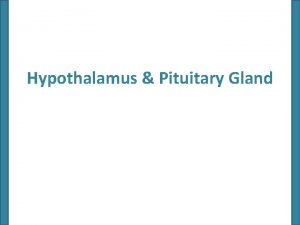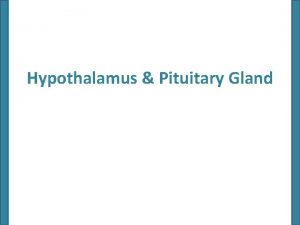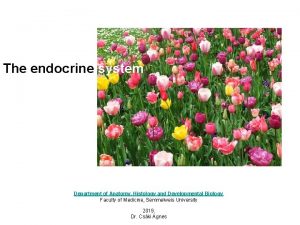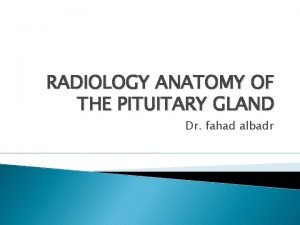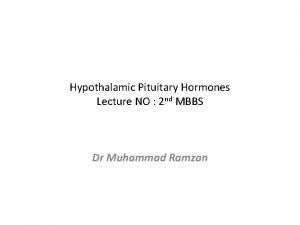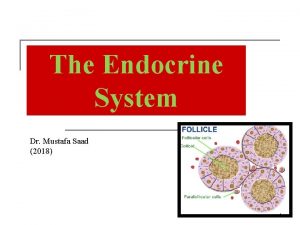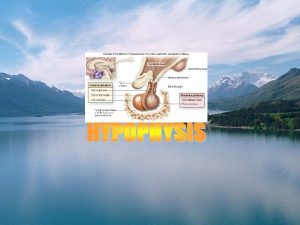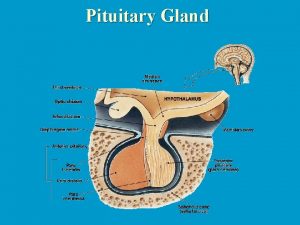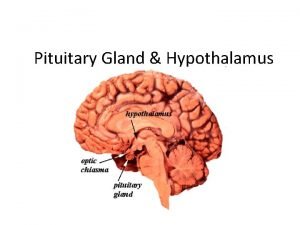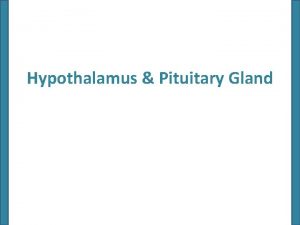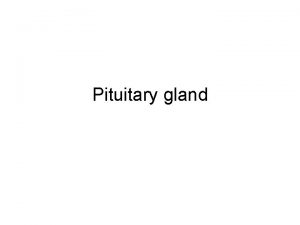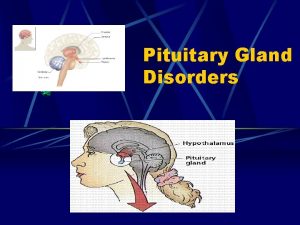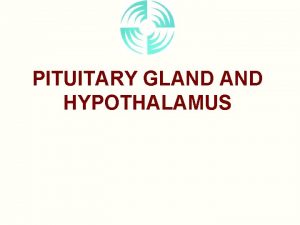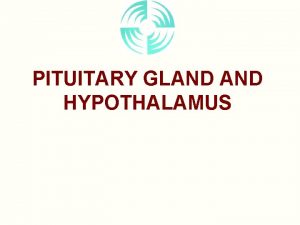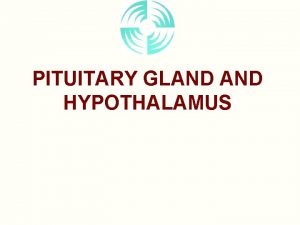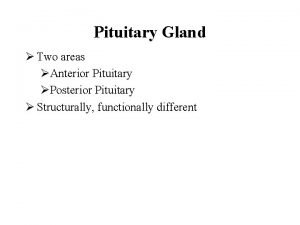The Endocrine System Hypothalamus Pituitary Gland The endocrine
















- Slides: 16

The Endocrine System Hypothalamus Pituitary Gland

The endocrine system is an integrated system of small organs that involve the release of extracellular signaling molecules known as hormones. A hormone is a chemical messenger that carries a signal from one cell to another. All multi-cellular organisms produce hormones. Hormones in animals are often transported in the blood. Cells respond to a hormone when they express a specific receptor for that hormone. The hormone binds to the receptor protein, resulting in the activation of a mechanism that ultimately leads to cell type-specific responses. The endocrine system is instrumental in regulating metabolism, growth, development and puberty, tissue function, and also plays a part in determining mood.

Endocrine system 1) Pineal gland 2) Pituitary gland 3) Thyroid gland 4) Thymus 5) Adrenal gland 6) Pancreas 7) Ovary 8) Testis

Hypothalamus The hypothalamus links the nervous system to the endocrine system via the pituitary gland. The hypothalamus, is located below the thalamus, just above the brain stem. In humans, it is roughly the size of an almond. The hypothalamus is responsible for certain metabolic processes and other activities of the Autonomic Nervous System. It synthesizes and secretes neurohormones, often called hypothalamic-releasing hormones, and these in turn stimulate or inhibit the secretion of pituitary hormones. The hypothalamus controls body temperature, hunger, thirst, [1] fatigue, anger, and circadian cycles.

Pituitary Gland The pituitary gland is sometimes called the "master" gland of the endocrine system, because it controls the functions of the other endocrine glands. The pituitary gland is no larger than a pea, and is located at the base of the brain. The gland is attached to the hypothalamus (a part of the brain that affects the pituitary gland) by nerve fibers. The pituitary gland itself consists of three sections: the anterior lobe the intermediate lobe the posterior lobe

Anterior lobe: • Growth hormone • Prolactin - to stimulate milk production after giving birth • ACTH (adrenocorticotropic hormone) - to stimulate the adrenal glands • TSH (thyroid-stimulating hormone) - to stimulate thyroid gland • FSH (follicle-stimulating hormone) - to stimulate the ovaries and testes • LH (luteinizing hormone) - to stimulate the ovaries or testes

Intermediate lobe: • Melanocyte-stimulating hormone - to control skin pigmentation Posterior lobe: • ADH (antidiuretic hormone) - to increase absorption of water into the blood by the kidneys • oxytocin - to contract the uterus during childbirth and stimulate milk production

The pineal gland (also called the pineal body, epiphysis cerebri, epiphysis or the "third eye") is a small endocrine gland in the vertebrate brain. It produces melatonin, a hormone that affects the modulation of wake/sleep patterns and photoperiodic (seasonal) functions. It is shaped like a tiny pine cone (hence its name), and is located near to the center of the brain, between the two hemispheres, tucked in a groove where the two rounded thalamic bodies join. Unlike much of the rest of the brain, the pineal gland is not isolated from the body by the blood-brain barrier system.

The pineal gland was the last endocrine gland to have its function discovered. Its location deep in the brain seemed to indicate its importance. This combination led to its being a "mystery" gland with myth, superstition and even metaphysical theories surrounding its perceived function. The pineal gland is occasionally associated with the sixth chakra (also called Ajna or the third eye chakra in yoga). It is believed by some to be a dormant organ that can be awakened to enable "telepathic" communication. In the physical body the eye views objects upside down. It sends the image of what it observes to the brain which interprets the image and makes it appear right side-up to us. But the human body has another physical eye whose function has long been recognized by humanity. It is called the 'Third Eye' which in reality is the Pineal Gland. It is long thought to have mystical powers. Many consider it the Spiritual Third Eye, our Inner Vision.

Thyroid Gland The thyroid controls how quickly the body burns energy, makes proteins, and how sensitive the body should be to other hormones. Parathyroid Gland release a hormone that regulates the amount of calcium in the blood.

Adrenal glands, which are also called suprarenal glands, are small, triangular glands located on top of both kidneys. An adrenal gland is made of two parts: the outer region is called the adrenal cortex and the inner region is called the adrenal medulla. Hormone Secreted by the Adrenal Cortex corticosteroid hormones hydrocortisone hormone - this hormone, also known as cortisol, controls the body's use of fats, proteins, and carbohydrates. corticosterone - this hormone, together with hydrocortisone hormones, suppresses inflammatory reactions in the body and also affects the immune system

The Adrenal Medulla secretes the following hormones: epinephrine (also called adrenaline) - this hormone increases the heart rate and force of heart contractions, facilitates blood flow to the muscles and brain, causes relaxation of smooth muscles, helps with conversion of glycogen to glucose in the liver, and other activities. norepinephrine (also called noradrenaline) - this hormone has little effect on smooth muscle, metabolic processes, and cardiac output, but has strong vasoconstrictive effects, thus increasing blood pressure.

Pancreas The hormones secreted by the endocrine tissue in the pancreas are insulin and glucagon (which regulate the level of glucose in the blood) and somatostatin (which prevents the release of the other two hormones).

Thymus Gland Hormones produced by this organ stimulate the production of certain infection-fighting cells. It is of central importance in the maturation of T cells.

Negative Feedback An example of negative feedback circuit is the heating system in your home. When the furnace produces enough heat to elevate temperature above the set point of thermostat, thermostat is triggered and shuts off the furnace (heat is feeding back negatively on the source of heat). When temperature drops back below the set point, negative feedback is gone, and the furnace comes back on. The product or hormone within a human body like the heat produced by the furnace will eventually inhibit the production of more hormones and or heat. The main understanding is the circuit is stopped when there is a “ship in the dock”. The ship being the hormone. When the hormone is not present the signal goes out to create it. When created it becomes the ship in the dock and therefore inhibits the production of more hormones or ships. So the created hormone when in certain concentrations becomes an inhibitor of its own production.

Neurons in the hypothalamus secrete thyroid releasing hormone (TRH), which stimulates cells in the anterior pituitary to secrete thyroid-stimulating hormone (TSH). TSH binds to receptors on epithelial cells in the thyroid gland, stimulating synthesis and secretion of thyroid hormones, which affect probably all cells in the body. When blood concentrations of thyroid hormones increase above a certain threshold, TRH-secreting neurons in the hypothalamus are inhibited and stop secreting TRH. This is an example of "negative feedback". The end product of hormone production becomes the inhibiting factor for its beginning
 Pituitary gland
Pituitary gland Hypothalamus and pituitary gland connection
Hypothalamus and pituitary gland connection Anterior pituitary
Anterior pituitary Pituitary gland and pineal gland spiritual
Pituitary gland and pineal gland spiritual Pineal gland pituitary gland
Pineal gland pituitary gland Follicular epithelium
Follicular epithelium Pituitary gland tumor mri images
Pituitary gland tumor mri images Division of pituitary gland
Division of pituitary gland Nerve supply of pituitary gland
Nerve supply of pituitary gland Hypophyseal fossa and pituitary gland
Hypophyseal fossa and pituitary gland Diaphragma sellae
Diaphragma sellae Acromegaly before and after
Acromegaly before and after Hypophyseal fossa and pituitary gland
Hypophyseal fossa and pituitary gland Hypersecretion of prolactin
Hypersecretion of prolactin Dwrfism
Dwrfism Blood supply of pituitary gland
Blood supply of pituitary gland Oxytocin
Oxytocin
